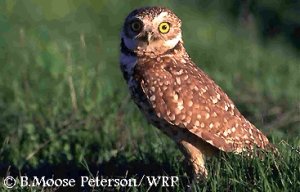Endangered Species Recovery Program | |
|
Home | News | Publications | Species profiles | Data and maps | About | Staff | Links | Department of Biological Sciences | CSU Stanislaus |

Western burrowing owl
Athene cunicularia hypugaea
STATUS
Federal and California Species of Concern
LIFE HISTORY
The western burrowing owl is a small ground-dwelling owl with a round head that lacks the tufts of feathers which are often referred to as ear tufts. It has white eyebrows, yellow eyes, and long stilt-like legs. The owl is sandy colored on the head, back, and upperparts of the wings and white-to-cream with barring on the breast and belly. Unlike most owls the male is slightly larger than the female and the females are usually darker than the males.
Burrowing owls are found in open, dry grasslands, agricultural and range lands, and desert habitats often associated with burrowing animals. They can also inhabit grass, forb, and shrub stages of pinyon and ponderosa pine habitats. They can be found at elevations ranging from 200 feet below sea level to 9,000 feet. In California, the highest elevation where this species is found is 5,300 feet in Lassen County. The owl commonly perches on fence posts or on top of mounds outside its burrow. These owls can be found at the margins of airports and golf courses and in vacant urban lots. They are active day and night, but are usually less active in the peak of the day.
Burrowing owls tend to be opportunistic feeders. Large arthropods, mainly beetles and grasshoppers, comprise a large portion of their diet. Small mammals, especially mice, rats, gophers, and ground squirrels, are also important food items. Other prey animals include: reptiles and amphibians, scorpions, young cottontail rabbits, bats, and birds, such as sparrows and horned larks. Consumption of insects increases during the breeding season. The burrowing owl hovers while hunting, similar to an American kestrel ( Falco sparverius), and after catching its prey it returns to a perch on a fence post or the ground. Burrowing owls are primarily crepuscular (active at dusk and dawn), but will hunt throughout a 24-hour period.
As their name suggests, burrowing owls nest in burrows in the ground, often in old ground squirrel burrows or badger dens. They can dig their own burrows, but prefer deserted excavations of other animals. They are also known to use artificial burrows.
Their nesting season begins in late March or April. The owls often line their nest with an assortment of dry materials. Six to 11 eggs are laid; the average number of eggs is 7-9. Incubation lasts 28-30 days and is performed by only the female. The care of the young while still in the nest is performed by the male. At 14 days of age, the young may be seen roosting at the entrance to the burrow, waiting for the adults to return with food. The young leave the nest at about 44 days and begin chasing living insects when 49-56 days old.
Distribution
The western burrowing owl is found in western North America from Canada to Mexico, and east to Texas, Louisiana. In certain areas of its range, it is migratory; this includes the northern areas of the Great Plains and Great Basin. Although the burrowing owls in northern California are thought to migrate, owls within central and southern California are predominantly nonmigratory.
CLASSIFICATION
Order STRIGIFORMES, Family STRIGIDAE, Genus Athene, Species cunicularia, Subspecies hypugaea
SUBSPECIES
As of 1993, there were up to 18 recognized subspecies of Athene cunicularia; 2 in North America: A. c. hypugaea inhabits North and Central America west of the eastern edge of the Great Plains south to Pamama; and A. c. floridana is found in Florida and on the Bahama Islands.
RECENT SYNONYMS
Speotyto cunicularia
OTHER COMMON NAMES
North American burrowing owl
REFERENCES
Haug, E.A. and L.W. Oliphant. 1990. Movements, activity patterns, and habitat use of burrowing owls in Saskatchewan. J. Wildl. Manage. 54:27-35; Plumpton, D.L. 1992. Aspects of nest site selection and habitat use by burrowing owls at the Rocky Mountain Arsenal, Colorado. M.S. thesis, Texas Tech. Univ., Lubbock; Haug, E.A., B.A. Millsap, and M.S. Martell. 1993. Burrowing owl ( Speotyto cunicularia). In The Birds of North America, no. 61 (A. Poole and F. Gill, Eds.). Philadelphia: The Academy of Natural Sciences; Washington, DC: The American Ornithologists' Union.
SIZE
Length:
21.6-27.9 cm (8.5-11 inches)
Wingspan:
50.8-61.0 cm (20-24 inches)
Weight:
170.1 g (6.0 ounces)
IDENTIFICATION
Burrowing owls lack "ear tufts" and are smaller in size than short-eared owls ( Asio flammeus). While in flight, they may be confused with other ground-roosting species, such as doves.
AUTHOR OF PROFILE
N. L. Brown